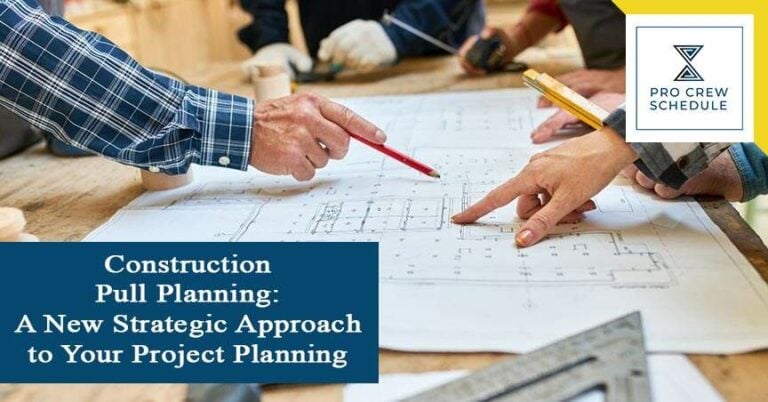Perhaps you are familiar with implementing the Critical Path Method (CPM) for scheduling your construction projects. In fact, it is one of the traditional and most common construction planning techniques. In theory, when your construction project has to be scheduled, CPM does make sense at the start of the project. Nonetheless, by practice, it is not always the best fit for a project for some apparent reasons.
However, an alternative planning method is getting popular today in the construction sector – Pull Planning. This rising alternative to CPM has yielded the best results for many construction projects. Pull planning helps your project run swiftly, and it can only take groundwork to layout at the start.
In this blog, we dive into a detailed overview of the Pull Planning method and provide you with its best practices and core rules that can help you get started on your following projects.
What is Construction Pull Planning?
Pull planning is a collaborative or two-way approach to project scheduling that takes an opposite approach to the sequence. This typically involves gathering team members to determine and isolate main project milestones. And from there, your crew works backward to add all requirements and other details. Think of it as a way to reverse-engineering the project.
Moreover, pull scheduling focuses more on the end goals and determines end predecessors project activity in the proper sequence of events. It helps to determine any activity or trade handoffs from the backend, allowing everybody on the project to be aware of when and what needs to be done to keep the construction project rolling.
The only best way this works is because all of your team members understand each detail of what project phase requires or project milestone, resulting in a more well-structured construction schedule. Speaking of the people involved, the following participants are also expected to join in the planning and feedback:
- Superintendent
- General foreman
- Design lead
- Trade lead from every trade involved
- Representative of the owner
- Scheduler
- Project manager
- Lead safety officer
- Quality assurance supervisor
Bringing all of these people altogether ensures that your construction team is on the right page and collaborating towards one common goal. Bring your crew members more with subcontractor scheduling software like Pro Crew Schedule. This all-in-one platform keeps everyone in a unified space, allowing more room for communication and collaboration.
Three Rules to Follow for Pull Planning in Construction
Pull planning in construction uses an upfront format including three fundamental rules that immensely assist the process. These three rules are consistently used in this particular method and revolve around the words “Pull”, “Collaborate”, and “Commit”. Altogether, they create the system known as pull planning, allowing you to be within schedule when managing construction projects constantly.
1. Pull
This is the very first rule of pull planning and is particularly very important. It comprises of completing the work that your client needs. However, the client in this scenario will be the painter, drywaller, electrician, plumber, or any subcontractor that has a job to do on-site.
You will be working backward from the end of the construction project. This allows the work to be finished at the correct time, instead of weeks too early. It usually places the subs in the way of others. If it is too late, it then puts the whole project in jeopardy of being behind.
It takes some knowledge and skills to know who to pull when. That is why you should be an experienced contractor. You are to be in charge of this technique to ensure it is done correctly.
2. Collaboration
The second rule is collaboration. Pull planning requires the greatest collaboration out of all construction methods used today. Everyone is expected to work together as a team so that the project leader understands what should be accomplished. Since everybody can add their inputs at any time, the whole group will have a much deeper understanding of what steps need to be taken next.
Collaboration, in regards to construction pull planning, revolves around the planning that is developed at the beginning of the project. However, it is crucial to make sure all notes added are as descriptive and detailed as possible.
You can best save all notes and other vital data using tasks management program. Software tools designed for project management have unique features like cloud storage. So, you and your team can easily access any files anytime and anywhere!
3. Commitment
The third rule is none other than commitment, and it is far by the most important rule out of the three. This particular rule ensures that no one ever touches another member’s note, assuming that it is much less necessary compared to others. In fact, everybody should agree not to change another member’s assigned tasks.
Your construction team surely wants to get the work finished first and foremost. However, it does not happen in a snap. In fact, everyone should first follow some guidelines so that no activity or work must be redone as the construction project progresses.
Ensure that every person involved in your future projects makes a solid commitment to flow with construction pull planning scheduling and performs their part of the project at the right time. Fortunately, tracking your crew’s work performance, assigned tasks, and labor hours is much easier and more efficient when you deploy subcontractor scheduling software. You get the latest updates and access information related to your people and projects.
Not everyone is quite a fan of pull planning the first few times they used it, mainly because they do not know how to do it correctly. If you consider implementing these three rules, you will find that pull planning is worth the time and effort.
Best Practices for Pull Planning
Before the pull, planning is done with notes, spreadsheets and other traditional ways. However, today, more and more task management programs are coming out to handle pull planning most digitally. Know that there is more to pull planning in construction than what you know and its success depends on how the planning process is being carried out.
So, we will share with you some of the best practices for construction pull planning, simplified:
- Get everyone on board and rally your construction team around. Involved all participating team leads and members with the goal that each of them must contribute relevant milestones and data towards the competition of the project.
- Set your milestones and follow them. Build milestones that are crucial to finishing project phases that ensure uninterrupted delivery of your project.
- Schedule your activities. After figuring out your phase plans, fix all of your set activities into your calendar.
- Arrange durations. Set up the duration of each of your planned project activities.
- Make weekly plans. From phase planning, identify how you can itemize your tasks and activities into weekly work plans.
- Schedule daily meetings. Having daily meetings before every single working day allows you to scrutinize all activities to keep tasks right on the course.
- Organized weekly meetings. Weekly meetings allow you to review weekly work plans and make adjustments when necessary.
- Update your plan. Updating any plan accordingly to both daily and weekly meeting results allow you to have a basis for adjusting the entire project schedule.
How Can Pro Crew Schedule Help?
Pull planning is best to implement when you are using construction scheduling software. Whether on-site or off-site, it allows you to digitalize all project details and have them accessible thru the app. It also improves your team’s overall productivity on the field and keeps the project right on track. In fact, a reliable project management software like Pro Crew Schedule can:
- Make team communication transparent – Real-time construction software like Pro Crew Schedule allows your construction team to communicate openly, while every crew knows the role and where they stand.
- Improves collaboration – It allows you to work on the project schedule method while improving overall communication and encouraging your whole team to work together.
- Optimize work and processes – By integrating your pull planning with project management software right at everybody’s fingertips, your team members can reduce their mistakes and fully optimize their work.
- Increased efficiency – Everybody on your team will have a much clearer idea of the steps and milestones needed to achieve them. A detailed understanding of their responsibilities combined with a software application helps streamline your workflows, ensuring that the project stays online and on track without the slightest glitch.
If you are looking for an integrated and simple project management tool to help you with pull planning, take Pro Crew Schedule for a spin! It comes with everything you ever need to pull off construction projects effectively. Start using it for free. We give a 30-day FREE trial for you to try!
Key Takeaways
The ultimate goal of pull planning is to promote a team environment called “We” instead of “Me”. Doing this creates a well-oiled machine of a construction team that collaborates and communicates effectively and works all together to determine and solve possible issues. As a result, each project continues to become more and more efficient.







